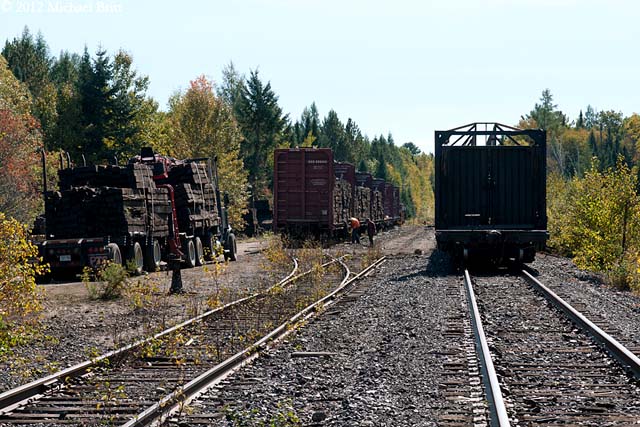
2012
|


Ties are recovered from the abandonment of Canadian Pacific's Chalk River Sub at Mackey - 28 Sep 2012 Mike
Britt.
4 October 2012
Reverse Logic at Work in Terms of Rail Travel
Carleton Place Ontario - We live in a Carleton Place neighbourhood where a rail freight line runs along the back of our property.
We bought this house with the full knowledge trains ran behind it. We've lived here for more than 20 years and have co-existed very nicely with the rail line.
Sure there was the odd occasion when shunting freight cars in the middle of the night woke us up. Once in a while a train engineer would blow the whistle too
long. And very rarely an idling engine proved to be an annoyance.
Mostly though, the trains just rolled past and disappeared into the distance, and more often than not they were a good time check. We got used to the daily
schedule and could pretty well predict when the next train would pass. We got so used to trains that the only time we took notice of them was when visitors
would comment on the fact the tracks were close to our place.
We like trains and are more than content to see them running through our community.
Now the only trains which pass our subdivision are work trains. Crews are in the process of tearing up the rail freight line between Arnprior and Smiths Falls.
They haven't reached Carleton Place yet but they are working in neighbouring Mississippi Mills, so our turn is coming soon.
The track itself and other infrastructure are being shipped west where it is being used to help lay a new line to the oil fields of northern Alberta.
Like so many Canadian communities Carleton Place was once a major rail hub. Freight and passenger services ran through the town and residents were once able to
hop on the train in the morning and travel to nearby Ottawa for work or a day of shopping in the big city. At night they took the train home.
Those days are long gone. My wife and I moved here 36 years ago and the daily passenger service to and from Ottawa was already a distant memory. The
cross-country train "The Canadian" called here right through the 1970s. But in the early 1980s the 28 kilometres of track between here and Nepean was
closed and in the blink of an eye the tracks were torn up. It was incredible how fast that line disappeared!
I was the editor of the local community newspaper at the time. I wrote editorials lamenting the loss of the passenger rail line and predicted we would all live
to regret that decision.
I'm sorry to say that I was absolutely right in this case. We now know that corridor and rail track would have been the perfect channel for a light rail
service from bedroom communities such as Carleton Place, Mississippi Mills, and Beckwith Township to Ottawa where so many of our residents work.
True, they have finally completed the four-laning of busy Highway 7 from Stittsville west to Carleton Place and that is a God-send.
OVERCROWDED ROADS
On the other hand ask anyone in the "commuter army" from here and they will tell you the new highway "only gets you to the jam faster."
Highway 417 through Kanata and Nepean remains a bottleneck and it will probably continue to be despite a project aimed at widening the roadway to three lanes
in each direction. There are simply too many cars and trucks, especially during rush hour Monday to Friday.
We need light rail to improve the passenger transportation links to the city. But with the rail infrastructure gone that is only a pipe dream. The cost of
re-establishing such a system from scratch is totally cost prohibitive. Certainly government, the taxpayers, can't afford to pay for it.
Shame on those short-sighted people who made the decision to tear up the passenger line in the early 1980s!
Now the same thing is happening to the freight line which, if there was any will to do so, could also serve as a passenger link.
But in a province where the road and street infrastructure is crumbling under the ever growing weight of more and more motor vehicles we are left with
virtually no other good surface travel options in so many communities. The bus is the best option here but that too is limited. At least you can grab a
Greyhound to Toronto.
The only rail alternatives for people here are in Smiths Falls or Barrhaven, in south Ottawa, where VIA Rail stations are in place. That line will get you to
Brockville, Kingston, Toronto, and points in between and is a very viable service. But the line is inaccessible to so many people across Eastern Ontario,
including ourselves.
They built a brand new VIA station in Smiths Falls recently. A great concept but the building is remarkably small, parking is limited, and the washrooms were
added as an afterthought. Part of the limited thinking that clearly surrounds passenger rail service in this country.
We recently returned from Great Britain where people also complain long and loud about the deteriorating passenger rail service.
There is very little to complain about that we can see. After flying to Glasgow, via London, we spent a few days in Comrie, Scotland, which is twinned with
Carleton Place. We were there for 20th anniversary observances and represented our community as members of the Sister City Committee which I currently chair.
Part two of our UK visit was a week in London. Kathleen and I and our friends Wendy and Frank LeBlanc (she is the current Mayor of Carleton Place) elected to
take the train from Scotland to London. We all enjoy train travel, especially in Europe where service is so much more advanced.
True there is no train to Comrie any more. Many small communities have been cut off which is unfortunate. But the train is not far away and the system works.
In this case our friend George Lees drove us to nearby Dunblane, the home of Olympic and U.S. Open men's tennis champion Andy Murray. I mention Murray because
in the wake of the Olympics there were signs in Dunblane congratulating their native son on his recent success.
From Dunblane we easily caught an early morning ScotRail commuter train to Edinburgh's Waverley Street Station. The ride was smooth as silk and we arrived
right on schedule.
Waverley Station doesn't have a lot to recommend it really. A big, ugly, barn of a place. But you can catch trains to communities across Scotland, England, and
Wales. We took the main east coast line from Edinburgh south to King's Cross Station in London, a very familiar destination for Kathy and me.
On this trip the only stops were in Newcastle-upon-Tyne, Darlington, and York, all in northeast England. From York it was a really fast, efficient run into
London.
They have renovated King's Cross over the past few years and it is even easier to get around now with new elevators added and other customer-friendly
improvements made. The taxi queue is in the same place it always was, opposite St. Pancras Station, and we soon caught a cab to our hotel.
A few days later we took the Brighton Express from Victoria Station in Central London to the south coast resort city, one of our favourite seaside destinations
in Britain. After an enjoyable sunny day in Brighton we reversed field and headed back to London on a late afternoon train.
Everything went absolutely swimmingly. With rail passes pre-purchased at our local travel agent's the process is amazingly simple. UK trains are almost as
efficient as the London Tube which is absolutely incredible by the way.
We've traveled across the length and breadth of Britain by rail over the course of 17 years and rarely had a problem.
Meanwhile back in Canada to call rail travel "service" is being far too generous. The system stinks quite frankly, and with more rail lines being
torn up as we speak, the situation can only get worse.
In this day and age with fuel costs high, main roadways overcrowded, and air travel cost prohibitive for many of us the railway just seems like such a
wonderful alternative. If we had any rail links to speak of that is.
Obviously there are numerous factors at work here. But for my money we have completely missed the boat when it comes to this fast, efficient, means of
transportation and that is a terrible shame for all of us. Where is the logic in what we are doing in Canada when it comes to public transport?
Jeff Maguire.

|


|
Vancouver Island
British Columbia
Canada
|
|